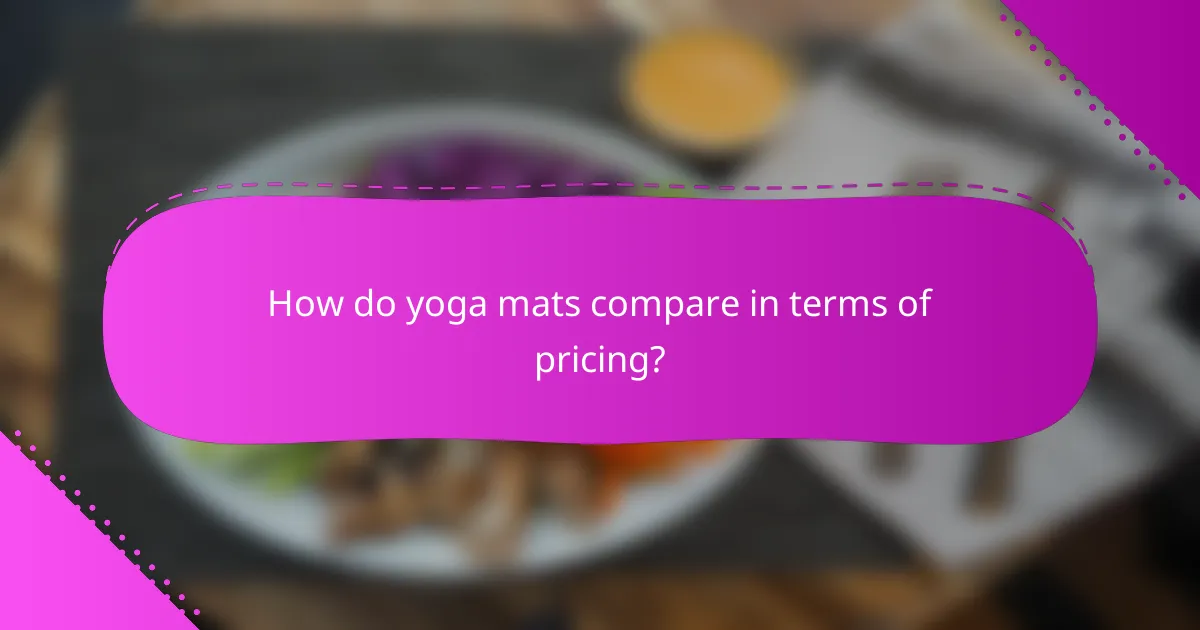A quality yoga mat is essential for enhancing comfort and stability during practice, ensuring a safe and enjoyable experience. By providing cushioning and a non-slip surface, it helps prevent injuries and allows practitioners to focus on their poses and breathing. Additionally, the portability of yoga mats makes it easy to maintain your practice anywhere, anytime.

How do yoga mats enhance comfort during practice?
Yoga mats enhance comfort during practice by providing cushioning, stability, and grip, which are essential for a safe and enjoyable experience. A well-chosen mat can significantly reduce discomfort and the risk of injury, allowing practitioners to focus on their poses and breathing.
High-density foam cushioning
High-density foam cushioning is a key feature of many yoga mats, offering support and comfort during various poses. This type of cushioning helps absorb impact, reducing strain on joints and muscles, which is particularly beneficial for those with existing injuries or sensitivities.
When selecting a mat, look for options with at least 5-10 mm of thickness in the foam layer to ensure adequate cushioning. Mats with higher density foam tend to provide better durability and maintain their shape over time, making them a worthwhile investment.
Textured surfaces for grip
Textured surfaces on yoga mats enhance grip, preventing slipping during practice. A good grip is crucial for maintaining balance and stability in poses, especially in styles like Vinyasa or Ashtanga, where movement is continuous.
Consider mats with materials like natural rubber or PVC, which often feature textured patterns. These surfaces help keep your hands and feet securely in place, allowing you to focus on your alignment and breathing without the distraction of slipping.
Thickness variations for personal preference
Yoga mats come in various thicknesses, catering to different preferences and practices. Thicker mats (around 6-10 mm) provide more cushioning, making them ideal for restorative practices, while thinner mats (around 3-5 mm) offer better stability for balance-focused poses.
When choosing a mat, consider your practice style and personal comfort. If you frequently practice on hard surfaces or have joint concerns, a thicker mat may be beneficial. Conversely, if you prioritize stability and connection to the ground, a thinner mat might suit you better.

What features improve stability in yoga mats?
Stability in yoga mats is enhanced by features that prevent slipping and ensure even weight distribution. Key elements include non-slip materials, thoughtful weight distribution designs, and wider dimensions that provide better support during practice.
Non-slip materials
Non-slip materials are crucial for maintaining grip during yoga poses. Mats made from natural rubber, PVC, or TPE often provide superior traction, reducing the risk of slipping. When selecting a mat, look for those with textured surfaces or additional grip features, especially if you practice dynamic styles like Vinyasa or Ashtanga.
Consider the mat’s performance in various conditions; for instance, mats that perform well in dry environments may not offer the same grip in humid conditions. Testing the mat in a store or checking user reviews can help ensure you choose a reliable option.
Weight distribution design
A well-designed yoga mat promotes even weight distribution, which enhances stability. Mats that are thicker in certain areas or have added cushioning can help distribute body weight more evenly, reducing pressure on joints and improving balance. This is particularly beneficial for those practicing poses that require significant support, such as Warrior or Tree pose.
When choosing a mat, consider its thickness; a standard thickness of around 4-6 mm is often suitable for most practitioners, but those needing extra support might opt for mats that are 8 mm or thicker. Ensure the mat’s design aligns with your practice style for optimal stability.
Wider dimensions for support
Wider dimensions in yoga mats provide additional support and stability, especially for practitioners with larger body frames or those who prefer more space during their practice. Standard mats typically measure around 24 inches in width, but wider options can range from 26 to 30 inches, offering more room for movement and comfort.
When selecting a mat, consider your personal space needs and the types of poses you frequently practice. A wider mat can help prevent overreaching and enhance balance, making it easier to maintain proper alignment during challenging poses.

How can yoga mats prevent injuries?
Yoga mats play a crucial role in preventing injuries by providing a stable and cushioned surface for practice. They help absorb impact, support proper alignment, and reduce the risk of slips and falls during various poses.
Shock absorption properties
Shock absorption is essential for minimizing the impact on joints during yoga practice. A mat with good cushioning can reduce stress on the knees, hips, and spine, making it easier to perform poses without discomfort. Look for mats that are at least 5 mm thick for adequate shock absorption.
Materials like TPE or high-density foam are known for their excellent shock-absorbing qualities. Consider testing different mats to find one that feels comfortable and supportive underfoot.
Support for joint alignment
Proper joint alignment is critical for preventing injuries during yoga. A quality mat provides a stable surface that helps maintain alignment in poses, reducing the risk of strain. Mats with alignment markings can assist practitioners in positioning themselves correctly.
When selecting a mat, ensure it offers enough grip to prevent slipping, which can lead to misalignment and potential injuries. A textured surface can enhance stability during dynamic movements.
Durable materials to withstand wear
Durability is an important factor in injury prevention, as worn-out mats can lose their cushioning and grip. Mats made from high-quality materials like natural rubber or eco-friendly TPE are designed to withstand regular use without degrading quickly. This longevity ensures consistent support throughout your practice.
Regularly inspect your mat for signs of wear, such as cracks or thinning areas. Replacing a worn mat can help maintain the protective qualities that prevent injuries during yoga sessions.

What are the best portable yoga mats available in Australia?
The best portable yoga mats in Australia combine comfort, stability, and durability, making them ideal for practitioners on the go. Key factors to consider include material quality, thickness, and weight, which all contribute to the overall experience during practice.
Manduka PRO Yoga Mat
The Manduka PRO Yoga Mat is renowned for its exceptional durability and comfort. Made from high-density PVC, it provides excellent cushioning and support, making it suitable for various yoga styles.
This mat is 6mm thick, offering a stable surface that helps prevent injuries during practice. While it is heavier than some alternatives, its longevity and performance make it a worthwhile investment for serious yogis.
Liforme Yoga Mat
The Liforme Yoga Mat is designed with eco-friendly materials and features a unique alignment guide printed on its surface. This mat is 4.2mm thick, providing a balance of comfort and stability, which is essential for maintaining proper form.
Lightweight and portable, the Liforme mat is ideal for those who travel frequently. Its non-toxic natural rubber construction ensures a good grip, even during sweaty sessions, reducing the risk of slips and injuries.
Jade Yoga Harmony Mat
The Jade Yoga Harmony Mat is made from natural rubber, offering excellent traction and cushioning. With a thickness of 5mm, it strikes a good balance between comfort and stability, making it suitable for various yoga practices.
This mat is lightweight and portable, making it easy to carry to classes or outdoor sessions. Additionally, for every mat sold, Jade Yoga plants a tree, contributing to environmental sustainability, which is a significant plus for eco-conscious users.

What criteria should you consider when selecting a yoga mat?
When selecting a yoga mat, focus on comfort, stability, injury prevention, and portability. These factors will enhance your practice and ensure you choose a mat that meets your specific needs.
Material type and eco-friendliness
The material of your yoga mat affects both comfort and grip. Common materials include PVC, TPE, and natural rubber, each offering different levels of durability and eco-friendliness. For those concerned about environmental impact, look for mats made from sustainable materials like natural rubber or jute.
Additionally, consider the mat’s texture, as this can influence your stability during poses. A textured surface can provide better grip, especially in sweaty conditions.
Thickness and weight
The thickness of a yoga mat typically ranges from about 3mm to 6mm. Thicker mats offer more cushioning, which can be beneficial for joint protection, while thinner mats provide better stability and balance. Choose a thickness that aligns with your practice style and comfort preferences.
Weight is another important factor, especially if you plan to transport your mat frequently. Lightweight mats are easier to carry, while heavier mats may offer more stability but can be cumbersome.
Price range and warranty
Yoga mats can vary significantly in price, typically ranging from around $20 to over $100. Higher-priced mats often feature better materials, durability, and eco-friendliness. Set a budget that reflects your commitment to your practice and the quality you desire.
Check for warranties as well, as a good warranty can indicate the manufacturer’s confidence in their product. Many reputable brands offer warranties ranging from one year to a lifetime, providing peace of mind with your purchase.

How do yoga mats compare in terms of pricing?
Yoga mats vary significantly in price, typically ranging from low-cost options around $10 to premium models exceeding $100. The price often reflects the materials used, durability, and brand reputation.
Comfort during practice
Comfort is a crucial factor when selecting a yoga mat, as it directly affects your practice experience. Mats with thicker cushioning, generally around 5-8 mm, provide more support for joints, while thinner mats, about 3 mm, offer better stability.
When considering comfort, look for mats made from high-quality materials like natural rubber or TPE, which tend to provide better cushioning and grip. Testing a mat in-store can help determine if it meets your comfort needs.
Stability
Stability is essential for maintaining balance during yoga poses. Mats with a textured surface or made from materials like natural rubber often provide better grip, preventing slips and enhancing stability.
When choosing a mat for stability, consider its thickness and weight. Heavier mats tend to stay in place better, while lighter mats may shift during practice. A mat around 4-6 mm thick strikes a good balance between comfort and stability.
Injury prevention
A good yoga mat can help prevent injuries by providing adequate support and grip. Mats that are too thin may not cushion your joints properly, leading to discomfort or strain during practice.
To minimize injury risk, select a mat that offers both cushioning and stability. Look for mats with good shock absorption and a non-slip surface to enhance safety during various poses.
Portability
Portability is an important consideration for yogis who travel or attend classes. Lightweight mats, typically weighing around 1-2 kg, are easier to carry, while thicker mats may be bulkier and less convenient.
When prioritizing portability, consider mats that come with carrying straps or bags. Foldable mats can also be a great option for those looking to save space while ensuring they have a quality surface for practice wherever they go.
